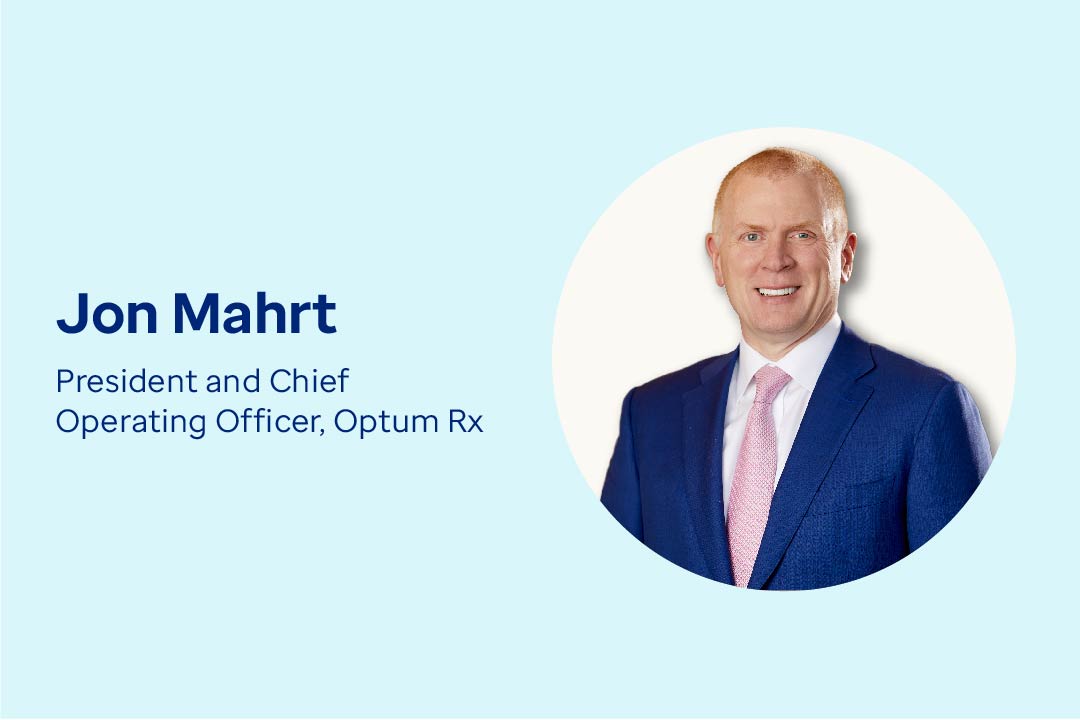Pharmacy benefit managers (PBMs) and pharmacy pricing are coming up more and more in the mainstream media. They've even drawn the attention of regulators and other policymakers.1,2
The common thread of these concerns is the sharply rising costs of prescription drugs. However, what’s sometimes missing in the conversation is that all drug pricing decisions are made by drug makers. In fact, the bulk of our work at Optum Rx now consists of trying to manage these increasingly higher costs for our clients.
This graph highlights the sharp rise in prices for new prescription drugs at launch in the U.S. from the years 2008 through 2021.
Finding new ways to make prescription drugs more affordable
In fact, we know that PBMs can save payers and patients 40% to 50% on prescription drug and related medical costs, compared to not using a PBM.3
In short, there’s no need for payers to choose between cost savings and straightforward, transparent business practices.
How? Optum Rx has always followed a transparent, evidence-based approach when we choose and negotiate prices for drugs. And each of our customers knows the best combination of affordability and transparency they need to best meet their pharmacy benefit needs. That’s why Optum Rx continues to find new ways to empower client, consumer and provider choice and make prescription drugs more affordable.
Let’s drill down here. Optum Rx is a lowest net cost-driven company. It’s one of the key ways we deliver a different level of value to the marketplace.
First, let’s clarify some terms that are central to ‘lowest net cost’:
Rebates
One of the principal roles for the pharmacy benefit management industry is to help their clients decide which drugs to pay for, and how. For Optum Rx, this means negotiating with drug manufacturers to drive toward the lowest net cost for medicines. This function is brought to life through the formulary process.
Transparency
A transparent business relationship is open, honest, and straightforward. That means sharing information for performance, revenue, sourcing, pricing, and business values.4
At Optum Rx, we make it even simpler: Transparency is designed to empower patients, providers, and plan sponsors to make informed decisions that can lead to lower prescription drug costs.
With Optum Rx, we have always led with transparency, while supporting client choice. For example, our clients can choose a fully pass-through pricing model, or a traditional rebate-based program, as they see fit.
Lowest net cost
The net cost for a branded prescription drug is the cost you pay after any rebates.
As mentioned, one of our key roles is negotiating drug prices with pharmaceutical makers on our clients’ behalf. We provide our clients with full transparency on how formulary decisions are made.
We are committed to formulary decisions leading to lower net cost for individual drugs or across drug classes. Whatever our decision, we will share the math that demonstrates how we made that choice.
Some of our clients choose to incorporate rebates into their plan design strategy; others do not. But by beginning with the lowest net cost, both clients can be sure that they are paying the right price.
Drug value vs. price
The advantage to clients of a lowest net cost approach comes from how we think about value versus price.
It’s common now to see new drugs with price tags that simply don’t match their clinical usefulness. A branded arthritis drug costs nearly 2,500% more than a generic alternative, despite being clinically the same.
Drastic value differences like this mean we have to make value-based judgments on drugs to help make prescription drugs more affordable for plan sponsors and members.
For us, drug value should support two goals:
- Help plan sponsors deliver the most clinically appropriate prescription benefit to their members.
- Help patients manage their care in the most cost-effective manner possible.
Lowest net cost in action
Optum offers a tightly integrated set of products and tools designed around the lowest net cost approach to help clients get the best value for their prescription drug benefit.
Let’s examine three examples: Formulary management, Vigilant Drug Program, and our biosimilars strategy. Each shows another way Optum Rx combines clinical value and lowest net cost to deliver improved care and lower costs.
Our rigorous, evidence-based clinical reviews are designed to ensure only the highest value new medications join our formularies.
1. Formulary management
Plan sponsors need a mechanism to translate low prices into effective medicines their members can use. Formularies play a key role.
In keeping with our value-based approach, every drug that makes its way onto one of our formularies must first pass through an extensive clinical review process.
Let’s look at formularies in more detail.
Clinical evidence leads
We use multiple teams of clinical experts to monitor important developments in drug therapy. For example, the Pharmacy and Therapeutics (P&T) Committee is comprised of independent clinical experts. Questions they will ask include:
- Does the drug have a unique therapeutic benefit?
- How does its safety and efficacy compare to other medications?
- Do its benefits outweigh its risks?
They determine which new medications are clinically meaningful, and deserve a spot on the formulary – before any cost considerations. Only then can the lowest net cost negotiation begin.
What select and premium formularies mean for you
Formularies are the backbone of an effective pharmacy benefit plan. Each formulary is designed to offer a specific balance between drug choice and cost savings:
- Select formulary: An open formulary that delivers savings by preferring more cost-effective products through tiering and utilization management strategies.
- Premium formulary: An open formulary that delivers savings through exclusion and utilization management strategies in select classes to maximize rebates.
- Premium Value formulary: A closed formulary that focuses on the lowest overall-net-cost alternatives without regard to rebates.
The Select and Premium formularies offer a choice of customized utilization management options, and ways to exclude certain drugs, for example, through the Optum Rx Vigilant Drug Program®. The Premium Value formulary is a self-contained product that comes packaged with our most aggressive management and drug exclusion tools.
The details differ, but each formulary model is designed to provide transparency, choice and customizable pharmacy benefit solutions. They help support the care quality, medication access, and cost considerations that are top of mind for every client and member.
2. Vigilant Drug Program
A troubling new trend involves new medications that carry hefty price tags, but offer little to no added clinical value. In many cases, there are generic alternatives available.
The Optum Rx Vigilant Drug Program® works by targeting high-cost brand and generic drugs that have lower-cost, clinically equivalent alternatives. Vigilant then excludes them from the formularies.
The Vigilant Drug Program comes as a modular design. So clients can decide which strategies best meet their unique needs based on member demographics, utilization patterns and value assessment.
The Clinical Duplicates drug list is one such module. It excludes drugs that are similar to existing approved drugs yet which offer little to no clinical benefit. In this example, Altoprev®, a branded cholesterol lowering drug, comes at a price that is nearly 1,200% higher than its clinical equivalent, the generic lovastatin:
Similarly, the High-Cost Brands with Generics module excludes branded drugs that cost much more than their generic equivalents. In this example, we see a branded antidepressant, Pamelor® priced well over eighteen thousand percent higher (18,321%) than its exact chemical twin (nortriptyline) in generic form.
The Vigilant Drug Program is a simple, flexible way to avoid unnecessary spending on drugs.
3. Biosimilars strategy
Optum Rx has developed a clear set of biosimilar guiding principles. They include maintaining clinical quality of care, flexibility, and choice. We have addressed our approach to clinical quality here. For now, let’s explore how we prioritized flexibility and choice as we analyzed the new biosimilars for Humira.
We have added multiple new biosimilars to our standard commercial formularies. In February we added Amjevita™, Amgen's biosimilar to our standard Premium and Select formularies.
In July we added Boehringer Ingelheim's Cyltezo®, and Sandoz's Hyrimoz® branded biosimilar to our formularies. Therefore, we now offer the first available biosimilar, Amjevita and the first interchangeable designated biosimilar, Cyltezo. Hyrimoz also fills a role being among the first high-concentration formulations of Humira.
Having high concentration and interchangeable options is important. They help address potential member and provider concerns when they are thinking about making a switch. That helps plan sponsors save money as more people use the lower-cost versions.
This range of options satisfies the guiding principle of flexibility and choice for our prescribers, clients, and members.
Here’s another example of how we make decisions that help keep options open for our customers.
The first biosimilar for Humira, Amjevita, came to the market with a high-wholesale acquisition cost version and a low-wholesale acquisition cost version.
Why would they do this? Basically, they are answering their market, which is calling for flexibility and choice.
Drug manufacturers alone determine the list price strategies for their products. They know that some clients in the U.S. want a high relative list price with a discount and rebates to get to a competitive net price. But they also know that other clients want a low list price, with no or minimal rebates in order to get to a competitive net price.
Now switch to viewing those same clients as Optum Rx clients. Some of them want that high relative list price and the rebate value, because they've built it into their benefit plan budget. Then there are others, perhaps with high deductible plans, plans with predominant co-insurance. These plans want the lowest list price available to them.
Optum Rx also wants to offer flexibility and choice. So we place both high and low list price products on our formulary in a similar position to each other, and to Humira. Now the clients can choose. They can cover one or the other, or they could cover both, the high list and the low list.
The overall effect of our lowest net cost approach to biosimilars means immediate lower client spending for a popular drug class, while members experience the same or lower out-of-pocket expenses.
A transparent, collaborative approach to lowering prescription costs
Lowest net cost is just one of the tools Optum Rx uses to help our clients and more than 60 million members achieve better health outcomes and lower overall costs. Our transparent, collaborative approach builds trust, so you can plan ahead with confidence.
Related content

Empowering clients with more choice and transparency

What’s changing the PBM industry?

8 ways to make drugs more affordable
References
- USC Leonard D. Schaeffer Center for Health Policy & Economics. The Association Between Drug Rebates and List Prices. Published February 11, 2020.
- White and Case. Five Drug Pricing Issues to Watch in 2023. Published December 20, 2022.
- Pharmaceutical Care Management Association. The Value of PBMs. Accessed June 23, 2023.
- Forbes. Transparency In Business: 5 Ways To Build Trust. Published April 3, 2019.
